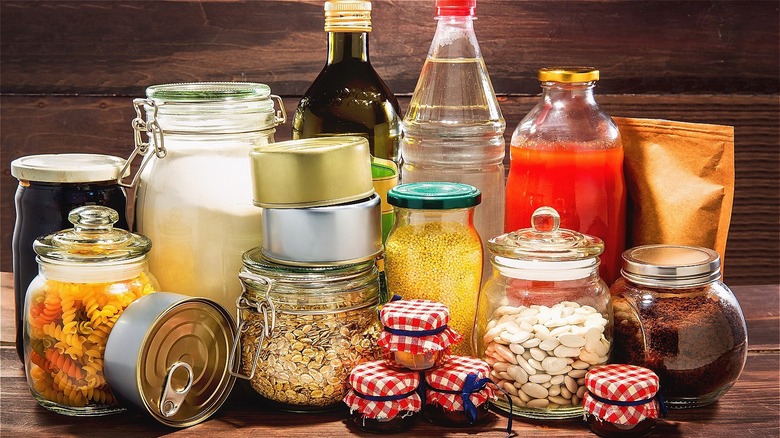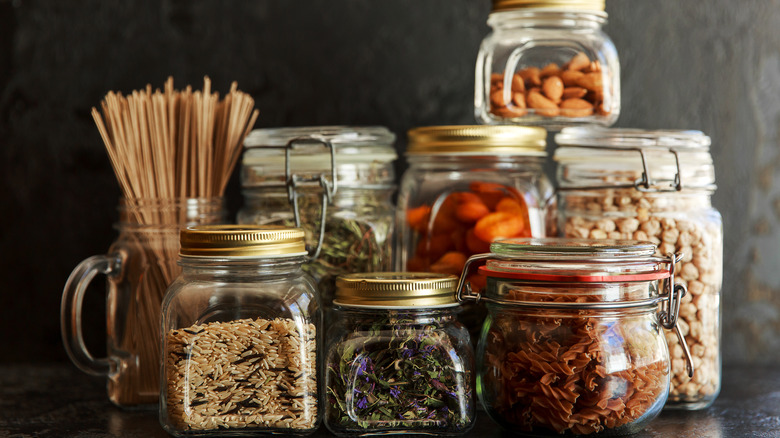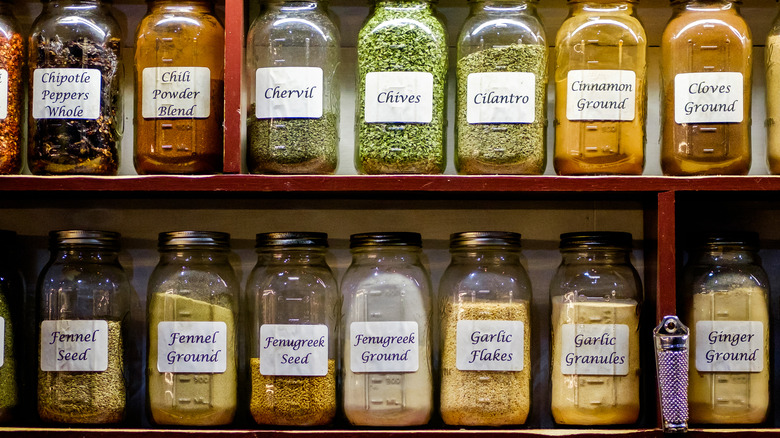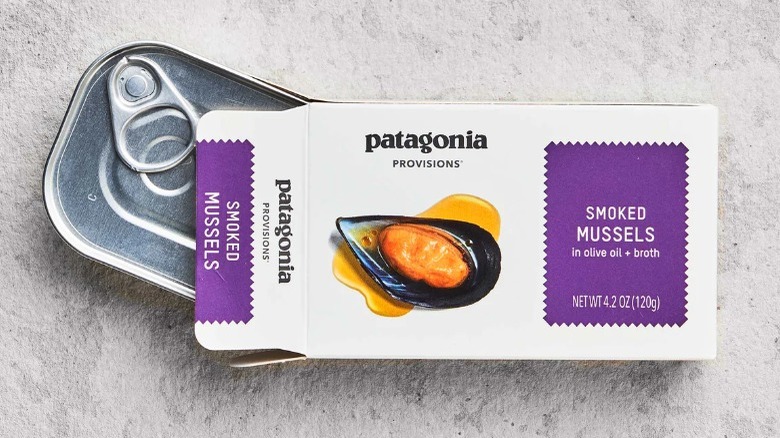What Does The Modern American Pantry Really Look Like?
During the early days of the pandemic, many of us appreciated the value of a stocked, well curated pantry — as it meant less time waiting in long grocery lines for rice and beans. Even when pasta was hard to find in supermarkets, home cooks with all-purpose flour and a little muscle could make homemade spaghetti. Lesson learned: Stocking up on essentials can save you time and money, especially when it's 7 p.m. and you haven't planned dinner. In the time it takes to boil a pound of pasta, a delicious meal can be thrown together from some canned tuna and a jar of sun-dried tomatoes, sprinkled with fresh breadcrumbs.
As much as we may covet color-coordinated pantries full of spices in matching containers, as seen on Instagram and shows like "The Home Edit," the average home cook's pantry is pretty messy. After all, it's in a constant state of change, often with many different hands pulling from it. Moreover, American home cooking has evolved as television and the internet have introduced diners to foods from around the world. There will always be a place for the staples found in our grandparents' pantries — flour, sugar, vegetable oil, canned foods, and other goods, as laid out by The New York Times' pantry-stocking instructions. The modern pantry, however, more often contains the international flavors, regional spices, and specialty ingredients once only available at select markets. Here's how to stock yours.
More and more pantry staples
Rice and pasta have a place in a modern pantry, but today, home cooks may want to make room for the wide variety of grains and starches available. Since these are often the star of the plate on Meatless Mondays or in vegetarian side dishes, a range of options ensures you'll have plenty to choose from come dinnertime. Rice is available beyond white and brown: We can also enjoy basmati and arborio rice, used for risotto. Other delicious grains are barley, farro, and quinoa. For pasta, there are many gluten-free options, as well as quality dried pasta made from durum wheat to complement any sauce you throw on it.
Asian noodle dishes make a satisfying main course any night of the week. Plates like pad Thai or dan dan noodles can be thrown together in minutes if you stock udon, ramen, rice noodles, and other staples in your pantry. For Middle-Eastern and Mediterranean dishes, you may want to store pearl-sized Israeli couscous or Italian fregola for a change of pace.
According to the USDA, canned goods will last indefinitely as long as they're in fine shape and stored in a cool, dry environment. (The quality of the product will deteriorate over time, however.) Keeping stocks and broths on hand can be key to lighter cooking when used instead of oil in a recipe, and they're always useful for soups and stews. Tomatoes are a lifestyle in the pantry, especially considering today's sheer variety of canned tomato brands for every budget and flavor preference, and can be used for everything from pasta dishes to Mediterranean recipes like chicken Provençal.
International spices
The modern American spice rack includes much more than salt and black pepper, and the condiment shelf needs considerable space. Chef David Chang has launched a line of products from noodle kits to jars of chili crisp and tamari for home cooks who don't live in one of the cities featuring his restaurant chain, Momofuku. Chang's product line makes creating complex, flavorful dishes simple in a few easy steps. His products have received excellent reviews, including one from a fan who said, "I add in a variety of vegetables, and in under 5 minutes, I have an awesome ramen meal."
According to McCormick spice company, the gazillion spices in your pantry won't spoil, so that's reassuring. However, over time, they will lose their potency. For the best flavors in your cooking, this is an excellent time to clear out those neglected spices you've had for years and make room for international flavors. Spices from the Middle East, Italy, and India are widely available and add lots of flavor to dishes without adding fat. Blends like za'atar, chat masala, garam masala, and sumac can add warmth to dips, soups, and stews, like curries and braises. Italian fennel or pollen adds a slight licorice taste that is wonderful on roasted meats.
Ethically sourced selections
For environmentally conscious consumers, a growing number of companies are creating sustainably sourced snacks from around the globe. Outdoor gear brand Patagonia has a food line of packaged goods, from meats to spices to beverages, that are sourced from like-minded global companies using "regenerative practices" for agriculture that benefits the planet. Produce is harvested from non-fertilized soil, for example, while wild seafood comes from sustainably run sources (via Patagonia Provisions).
Meanwhile, brands like Barnana are "upcycling" products that would otherwise go to waste, turning them into organic treats made from, in this case, bananas from family farms that would have had to throw them away. Project 7 makes familiar sweet and sour gummy candies, but with "organic, non-GMO, fair trade, preservative-free ingredients," and in return for sales, the company gives back to seven areas of need: "clean water, tree plantings, homelessness, feeding the hungry, anti-bullying programs, malaria treatments, and education."
The pandemic has drawn additional interest from consumers in healthier snack options, per Food Navigator, making products like nut-based bars and fair trade chocolate more in-demand than niche. Though these snacks can cost nearly twice the amount of their processed counterparts, shoppers are showing that they're willing to pay the difference. As more companies move into the market, they price gap may narrow.
Fine finishing touches
Gone are the days when American pantries had one type each of salt, oil, and vinegar. Celebrity chefs may have drawn your attention to finishing products that are added at the last minute to elevate the flavor of a dish. For example, Ina Garten swears by three different salts, two of which are fleur de sel (French sea salt) and Maldon flaked sea salt, to be added just before serving (via NYT Cooking).
Finishing oils, like high-quality extra virgin olive oil, can be a splurge. Martha Stewart suggests treating these like wine: First, taste a bit to see if you like the flavor, then add it to salads and or meat dishes coming out of the oven. Options include hemp seed oil, walnut oil, truffle oil, and beyond. These products never touch the cooking heat directly, maintaining their delicate flavor and integrity.
Just as you squeeze a lemon to add brightness to a dish, you can substitute a few teaspoons of vinegar for a finishing touch. Wine vinegar — such as red, white, Champagne, sherry, and rice — is versatile and used in both dressings and cooking. Balsamic vinegar runs the gamut from thin, inexpensive varieties to thick syrups that cost hundreds per bottle. Add a drop of the good stuff in both savory and sweet recipes.
Everyone's kitchen varies and should be built upon their needs and tastes. The modern American pantry is constantly evolving thanks to chefs like Anthony Bourdain, who bring us along on their culinary adventures and expand our ideas about what belongs on our plates.




